Diseases (infectious Bursa diseases)
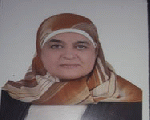
2023-08-30 13:09:56
A viral disease that affects chickens at young ages and affects the lymphoid tissue of the gland of his Fabricius(brucea) .The disease most often appears at the age of 3-6 weeks when the Bursa Bursa is fully developed) ).The danger of this disease lies in the fact that there is an inflammation in the factory gland responsible for the formation of immunity in the first weeks of life, when the chick is at the peak of its growth and activity, thereby disrupting the immune system in the bird and weakening its resistance and making it vulnerable to many other viral, bacterial or parasitic diseases, which makes many call it (chicken AIDS).
This disease should be known that it is a viral disease and its spread will be rapid among farms, for example, if in a farm with more than one role and one of them is infected with Gamboru, we expect it to appear in a large percentage in the other roles. Also, if an infected farm is very close to another farm, the chances of spreading are very high.
Pathogen: virusbirna virus is a virus without a wall and is called jamboro, a dangerous disease that attacks and destroys the lymphocytes located in the follicle of fabricia, the special organ responsible for strengthening and strengthening the immune system and producing B cells at the age of 15 days – 10 weeks of the bird's life, a highly infectious virus that is difficult to eliminate in case of spread, especially within agricultural or production facilities, as it is transmitted between birds through feces
The disease is called jumboro, attributed to the name of the American town jumboro in Delaware, USA, where it was discovered in 1962, and then found in other countries around the world after that, immunization has helped to prevent and control the spread of this disease and its transmission within a number of regions around the world, but what worries us here is that there are new genetic chains of the disease appear and there is a prevalence of subclinical heterotopia.
The gumburu virus is resistant to weather conditions and can remain in unsanitized amber for months. It is not affected by disinfectants and therefore the best disinfectant for it is Fur Con S. A mutated virus has genetic traits and mutual immunity between mutated viruses does not occur to a very narrow extent.
Incubation of the disease:
From 5 - 10 days and the duration of the disease is from 8-10 days approximately.
Ways of transmission of infection: 1 - the infection is transmitted from one bird to another through feces, drinking water and feed.2-the methods of tools for poultry farms and workers ' clothing are transmitted from one ward to another.
Path of the virus: the virus enters through the digestive tract and multiplies in the liver and then moves to the bursa sac and destroys the Bursa gland and lymphocytes . It spreads through the blood to all organs of the bird's body
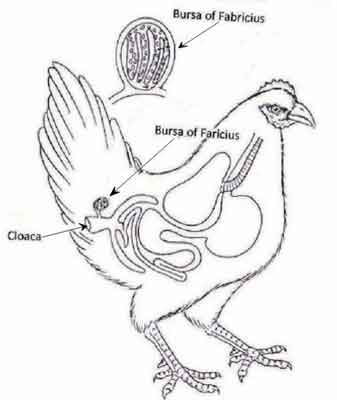
Pathological symptoms:
The symptoms appear suddenly in the flock and spread very quickly in the form of lethargy and general laziness of the bird with unwillingness to move, with the bird sleeping and refraining from eating and drinking, with foamy yellowish watery diarrhea with wetting the feathers of the compound area with its inflammation, which stimulates birds to peck that area, and the percentage of sick birds is high, ranging from 10-30%, and the highest death rate is on the third day of the onset of the disease and then decreases within five days .The percentage of chicks with symptoms ranges from 10-20%.Fattening chicks are more affected by the disease due to the Chick's exposure to the period of abstinence from eating, growth stops and the rate of food conversion worsens, in addition to a decrease in immunity The bird was exposed to other diseases.
Anatomical character:
When dissecting a chick with jumbo symptoms, we see hemorrhagic spots on the chest and thigh muscles, as well as between the glandular stomach and the sternum .
Changes appear in the kidneys, their vessels swell, the ureters are filled with urea, and the color of the kidneys varies from red to pale gray.
Fabrechous balanoposthitis is characteristic first of all from the outside mucus appears around them and swells in size .Their color varies from the outside from light red to dark red, and from the inside the folds and the inner cavity turn from white to red and are covered with mucous and fibrinous secretions .It may contain blood spots. Then atrophy of the giblets occurs.
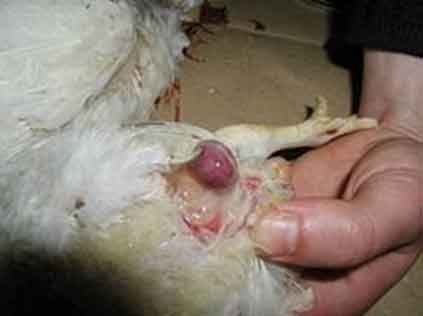
Diagnosis of the disease: .
1-symptoms and anatomical character. 2-sending a sample to the laboratory of chicks with symptoms and dead. In order to diagnose between this disease and similar diseases such as coccidiosis, Newcastle and fungal poisoning
Prevention and treatment : there is no cure for the disease and the solution lies only in the Prevention of biosecurity and Immunization, the temperature of the Amber can be raised two degrees when the disease is suspected, and vitamin K should be intervened to treat bleeding due to the effect of this disease on the body's immune system, which follows from poor response to other vaccines for other diseases and the bird's susceptibility to other diseases. Therefore, the Prevention of this disease is by adhering to the implementation of a good immunization program to obtain the best results .It is known that it is a viral disease and any viral disease has an immunization for protection and prevention against it, but it is preferable to measure immunity in birds to determine the level of maternal immunity so as not to interfere with immunization and existing immune bodies as a result of maternal immunity transmitted from mothers to chicks through the egg:
1-immunization of fattening herds: there are two methods of immunization : the first is immunization in stable areas where vaccination is done twice at the age of 12 days and at the age of 23 days with a medium ferocity intermediate strain (78)). immunization is done in drinking water because it is the natural route of the virus or by eye instillation to ensure the success of immunization. The second method : immunization using a very virulent strain (intermediate plus strain 228) or Persil Plus , and this is only once and should be after the age of 13 days , not less, the reason for this is that the very virulent strain enters the liver and destroys lymphocytes, and since fibroblasts form in the liver and migrate to the peripheral immune system ( spleen, harder gland and lymph nodes in the intestine ) this migration is completed after 13 days to complete its work in the peripheral immune system, if you get vaccinated before this period, you will cause a disease and cause immunosuppression .
It is not preferable to immunize at the age of a day with a live vaccine, because mothers producing chicks are usually immunized with a dead vaccine before the production period, and therefore transmit maternal immunity to Chicks, if immunization is done at the age of a day, it must be returned after 3 days, as this early immunization leads to the equation of maternal immunity and the second immunization is the basis.
Therefore, it is preferable to vaccinate the chicks at the age of one day in the hatching laboratory with a genetically engineered vaccine that carries the stem of the virus responsible for the disease, and not the live virus .vaccination is done by injection under the skin in the neck and then not repeated vaccination in fattening chicks against the jamboro virus during the rearing period(1-45 days).
2-vaccination in mothers and eggs: since these birds are long-lived and the brood pouch takes a longer time to atrophy, therefore we must vaccinate 3 times a live vaccine to protect the mother, the first being at the age of 12 days and between each vaccination another 11 days . It is better to vaccinate in the middle of the breeding period with the dead vaccine and thus support vaccination with the dead vaccine before the production period, and these birds have higher and more homogeneous immunity, and the percentage of chicks resulting from them carry immune bodies against gumburu disease .
In case of actual infection with the disease, the treatment is as follows::
Compulsory immunization is not used in this case, but symptomatic treatment is prescribed as follows:
1-a group of vitamins is developed, the most important of which is vitamin K because of its role as an immunostimulant, and at the same time it treats bleeding that occurs as a result of the disease, as well as vitamin E + selenium as an immunostimulant, and it is preferable to give imported good quality varieties that contain high concentrations of vitamin E
2-give the bird special preparations for the immune lifter. The immune lifter is very important in case of injury because, as mentioned, this disease leads to inhibition of the immune system of the bird and also the best immune lifters that contain new substances that have a role in activating immunity, such as betaglucan .
. Put liver stimulants such as heparinol, hep-BIAL or hep-Amarin to activate the liver 3-
.I want to mention that the role of dialysis is very important to reduce the severity of injury and death and activate the bird to resist this disease 4-
.This is in case there are other infections with the disease.The bird does not take any antibiotics, especially during the first 3-5 days from the onset of symptoms on the flock 5-
The drug is downloaded at a rate of continuous drops every 12 hours and it is possible to put steroids with vitamins with washing in one water and the other 12 hours any other drugs for secondary infections, preferably probiotics plus prebiotics for 3-5 consecutive days.
6-spray the air inside the ward and brush with any disinfectants such as iodine or Veron s to reduce the infection of the virus.
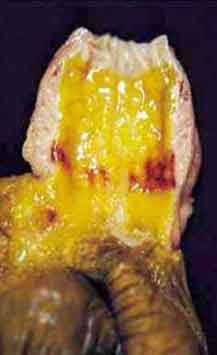
الموضوعات المشابهه

Important information about poultry diseases

What to treat an animal with pneumonia..

Contract agriculture and its relationship to sustainable
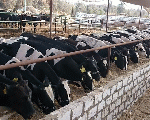
26 cattle and 1400 chickens died in

The poultry industry between the challenges of
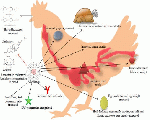
The role of chromium in the health
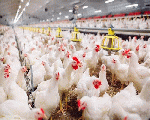
The role of chromium in poultry nutrition
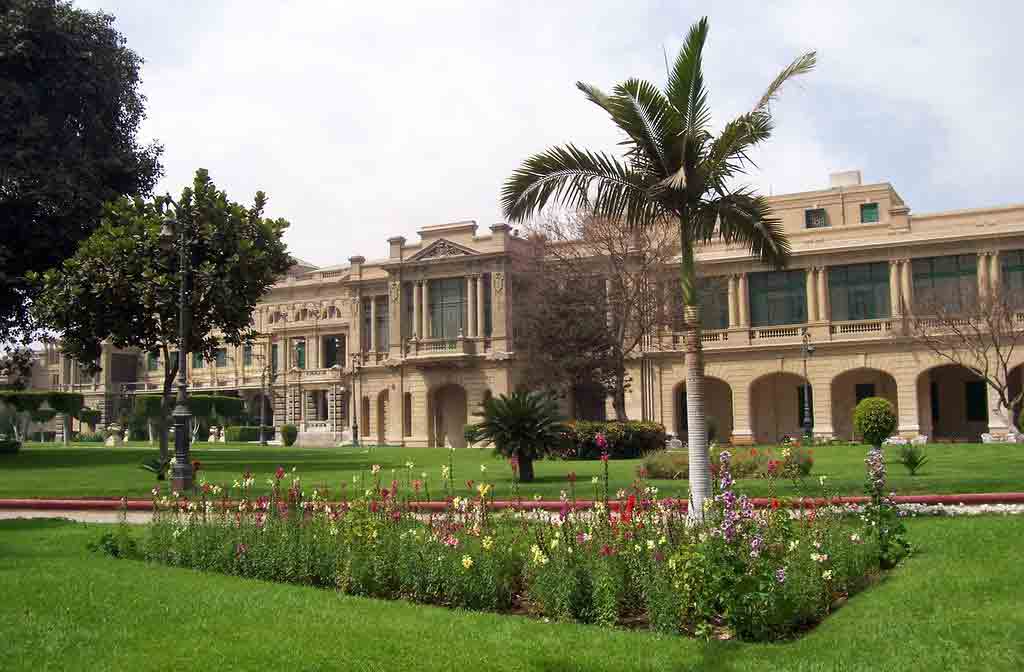
Agriculture receives an official delegation from the

The use of dietary nucleotides in poultry
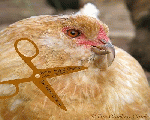
What's after spawning.?

Tips for broiler breeders to deal with

Diseases (infectious Bursa diseases)

Comments
Add comment